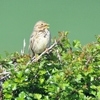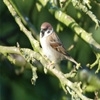Since 1970, some of our most beloved songbirds have declined drastically. Scientific evidence shows that substantial changes to farming practices has had the greatest impact on songbird populations. Around 77% of the UK is now farmland.
 |
 |
 |
Yellow wagtail - declined
by 70% |
Corn bunting - declined
by 86% |
Tree sparrow - declined
by 97% |
Over the decades, increasing demand for human food production has driven the development of more intensive farming practices. This has contributed to a loss of songbird habitat, safe nesting sites, and their vital food sources. For example, the use of pesticides and fertilisers on crops and grassland, the switch from spring to autumn sowing of arable crops, the loss of over-wintered stubbles and mixed farming have all contributed to the decline of our songbirds.
How our innovative beetle banks help songbirds to thrive
 One of our innovations was the beetle bank. These are low grass banks running through crops where insects can thrive. They are important because, as cereal fields increased in size and their centres became farther away from field boundaries, ground beetles that overwinter in hedgerows and fencelines could not spread into the centre of the crop.
One of our innovations was the beetle bank. These are low grass banks running through crops where insects can thrive. They are important because, as cereal fields increased in size and their centres became farther away from field boundaries, ground beetles that overwinter in hedgerows and fencelines could not spread into the centre of the crop.
Now when pests invade crops, there are no predatory beetles to eat them and farmers are forced to use pesticides.
There are now beetle banks on 377 farms across the UK, producing over 12 million beetles for songbirds to eat whilst also providing safe nesting sites. Our research shows that farmers who maintain beetle banks rarely need to use a summer insecticide.
Maximise field corners to improve songbird numbers
 Field corners tend to be unproductive areas of crop because they are difficult to work and subject to a good deal of compaction. A good solution is to square off the field and take the awkward corners and irregular edges out of cultivation. We can help farmers to develop these areas for wildlife.
Field corners tend to be unproductive areas of crop because they are difficult to work and subject to a good deal of compaction. A good solution is to square off the field and take the awkward corners and irregular edges out of cultivation. We can help farmers to develop these areas for wildlife.
Grow areas of mixed seeds for wild birds on farms
Modern farming leaves little residue seed for birds, so we work with farmers to grow a few areas of crops especially for birds.
- In summer, millet, linseed and triticale grown as strips alongside nesting cover make an ideal mix for finches and sparrows.
- In winter, kale provides cover and keeps the ground moist and warm, allowing thrushes and insectivorous birds to feed in safety.
Ensure farmers leave overwintered stubble
 Traditional crop rotations involved winter and spring crops with a grass ley break or root crop. Modern rotations mostly comprise only winter crops such as wheat and oilseed rape, so the land gets cultivated all at once immediately after harvest. We’ve proved that leaving small areas of stubble is important for protecting nest sites from predators and keeping birds warm in winter.
Traditional crop rotations involved winter and spring crops with a grass ley break or root crop. Modern rotations mostly comprise only winter crops such as wheat and oilseed rape, so the land gets cultivated all at once immediately after harvest. We’ve proved that leaving small areas of stubble is important for protecting nest sites from predators and keeping birds warm in winter.